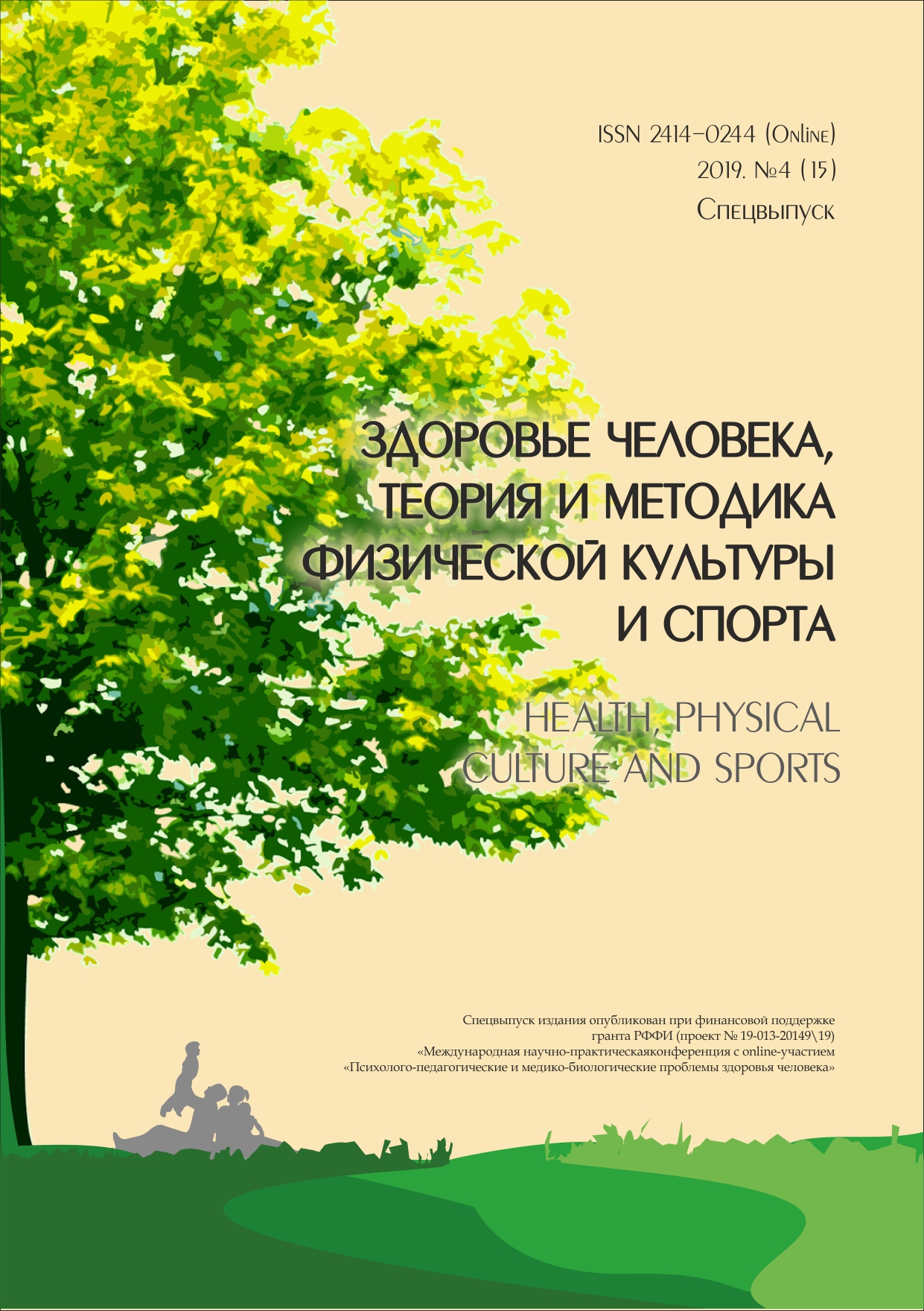INFLUENCE OF COLOR PHOTOSTIMULATION ON COORDINATION OF MOVEMENTS
Abstract
One of the most important conditions for human life is maintaining coordination ofmovements. Many parts of the central nervous system take part in the control of movements, thechange in the functional state of which affects the organization of movements. Through varioussensory systems (including through the visual), our brain receives feedback about the process ofdeviation from the vertical. Visual stimulation is one of the methods for correcting the functional stateof the brain. It is known that different colors and the frequency of stimulation have a multidirectionaleffect on humans. The response to color stimulation of the bioelectric activity of the brain in aselected frequency range leads to the formation of a given functional state. In particular, duringphotostimulation in the alpha EEG range (8–14 Hz), the subjects show positive shifts in their health,activity, mood, and anxiety levels, and the level of stress decreases.The study was conducted in the morning with the voluntary participation of 29 Altai StateUniversity students aged 18 to 22 years of different sexes. A total of 116 experiments were conductedto study the effect of color photostimulation on coordination of movements.The article presents the results of a study of the effects of photostimulation in red, green andblue on the performance indicators of coordination of movements on the stabilograph platform. Thetarget test was used.The results obtained indicate that photostimulation with green and blue at a frequency of 10 Hzhad an optimizing effect on the functional state of the subjects’ brains, which led to an increase inthe efficiency of their targeted movements, i. e. a person better controlled and controlled his bodycompared to a situation where stimulation was not carried out. A more significant improvement inmotor coordination was observed when using green for these purposes.The results of the study can be used to study the possibilities of improving coordination ofmovements by photostimulation in green in the areas of human activity associated with motor activity
Downloads
References
Иванова Е. В. Методика развития координации движений рук у девочек, занимающихся художественной гимнастикой, на этапе начальной подготовки: автореф. дисс. … канд. пед. наук. Чебоксары, 2009. 24 с.
Кузнецов В. С. Теория и методика физического воспитания и спорта. М.: Академия, 2009. 480 с.
Лях В. И. Совершенствование специфических координационных способностей // Физическая культура в школе. 2001. № 2. С. 7–14.
Миниханов В. А. Развитие координационных способностей в процессе спортивной тренировки занимающихся спортивными видами единоборств с применением специфических двигательных тренировочных заданий // Педагогико-психологические и медико-биологические проблемы физической культуры и спорта. 2018. Т. 13, № 2. С. 63–70.
Struikhin I. A., Minikhanov V. A., Eganov V. A. Pedagogical substantiation of the training influences orientation to tactical-technical actions by means of motor-coordinating training in Kyokushinkai //Sovremennye problem nauki I obrazovaniya. 2015. Vol. 4. P. 158–163.
Слива С. С., Войнов И. Д., Переяслов Г. А., Слива А. С. Стабилографическая экспресс-оценка психофизиологического состояния человека: методические рекомендации. Таганрог: ЗАО «ОКБ «Ритм», 2011. 38 с.
Gagey P.-M., Ouaknine M., Sasaki O. Pour manifester la dinamique de la stabilization // Posture et équelibre. Neuveautés 2001, conceptuelles, istrumentales et cliniques, Lacour M., Solal. Marseille, 2002. P. 73–79.
Араби Л. С., Сысоев В. Н., Кремнева Т. В. Аудио-визуальная стимуляция в комплексной терапии психогенно обусловленных расстройств // Вестник психотерапии. 2011. № 39. С. 9–17.
Серов Н. В. Цвет культуры: психология, культурология, физиология. СПб.: Речь, 2004. 642 с.
Голуб Я. В., Жиров В. М. Медико-психологические аспекты применения свето-звуковой стимуляции и биологически обратной связи. СПб.: КЭРИ, 2007. 93 с.
Сандомирский М. Е. Аудиовизуальная стимуляция в групповой психотерапии // Медицинская наука: материалы республ. конференции молодых ученых Республики Башкортостан. Уфа: Баш. Гос. мед. университет, 2003. 111 с.
Сериков А. Л. Аудио-визуальная стимуляция в терапии пограничных нервно-психических расстройств: дис … канд. мед. наук. Томск, 1998. 150 с.
Осипова М. А., Арьков В. В., Тоневицкий А. Г. Модуляция альфа-ритма и вегетативного статуса человека с использованием цветовой фотостимуляции // Бюллетень экспериментальной биологии и медицины. 2010. № 6. С. 699–703.
Федотчев А. И., Бондарь А. Т., Ларионова А. В., Пивоварова О. В. Изменения спектра ЭЭГ и субъективных характеристик состояния человека при двух типах организации суперпозированных световых воздействий // Физиология человека. 2004. № 5. С. 12–17.
Доценко В. И., Усачев В. И., Морозова С. В., Скедина М. А. Современные алгоритмы стабилометрической диагностики постуральных нарушений // Медицинский совет. 2017. № 8. С. 116–122.
Черенкова Л. В., Бердичевская Е. М., Балуева В. А. Стабилографические характеристики постуральной регуляции высококвалифицированных гребцов на каноэ с учетом функциональной асимметрии // Физиология и спортивная медицина. 2015. № 4. С. 82–86.
Леонова А. Б., Кузнецова А. С. Функциональные состояния и работоспособность человека в профессиональной деятельности // Психология труда, инженерная психология эргономика / под ред Е. А. Климова и др. М.: Юрайт, 2015. 618 с.
Rilk A. J., Soekadar S. R., Sauseng P., Plewnia C. Alpha coherence predicts accuracy during a visuomotor tracking task // Neuropsychologia. 2011. Vol. 49 (13). P. 3704–3709.
Яценко М. В. Влияние цветовой фотостимуляции на психофизиологические показатели и биоэлектрическую активность центральной нервной системы (на примере студентов вуза): монография. М.; Берлин: Директ-Медиа, 2018. 119 с.
Базанова О. М. Современная интерпретация альфа-активности ЭЭГ // Международный неврологический журнал. 2011. № 8. — С. 96–104.
An author should not normally publish manuscripts describing essentially the same research in multiple journals or publication venues. Such redundant publication is generally considered to constitute unethical publishing behavior, and if discovered may result in a manuscript under consideration being rejected, or a published article being retracted.
Authors of manuscripts reporting on original research should present an accurate account of the work performed, accompanied by an objective discussion of its significance. Underlying data should be represented accurately in the manuscript. The manuscript should contain sufficient detail and references to permit others to replicate the work. The fabrication of results and the making of fraudulent or knowingly inaccurate statements constitute unethical behavior and may be cause for rejection or retraction of a manuscript or published article.





